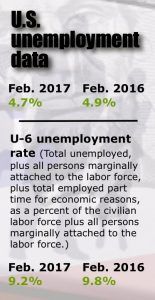U.S. economy adds 235,000 jobs, jobless rate falls to 4.7% with U-6 rate at 9.2%
by March 10, 2017 12:07 pm 392 views

The U.S. economy added a healthy 235,000 jobs in February as employers in the construction trade, manufacturing sector, health care field and private education services added nearly half of the new positions.
According to data released Friday (March 10) by the U.S. Bureau of Labor Statistics (BLS), the U.S. jobless rate in February remained steady at 4.7%, down one-tenth of a percentage point from the previous month when employers added 227,000 to payrolls. Over the past year, the nation’s unemployment figure has held at a range between 4.6% on the low end in November and 5% in March and April of 2016.
The U.S. employment picture follows the closely-watch ADP National Employment Report released on Thursday, which showed private sector employment increased by 298,000 jobs from January to February.
“February proved to be an incredibly strong month for employment with increases we have not seen in years,” said Ahu Yildirmaz, vice president and co-head of the ADP Research Institute. “Gains were driven by a surge in the goods sector, while we also saw the information industry experience a notable increase.”
Mark Zandi, chief economist of Moody’s Analytics added, “February was a very good month for workers. Powering job growth were the construction, mining and manufacturing industries. Unseasonably mild winter weather undoubtedly played a role. But near record high job openings and record low layoffs underpin the entire job market.”
Overall, the number of unemployed persons, at 7.5 million, changed little in February. Among the major worker groups, the unemployment rate decreased for Whites 4.1% in February, while the jobless rates for adult men (4.3%), adult women (4.3%), teenagers (15%), Blacks (8.1%), Asians (3.4%), and Hispanics (5.6%) showed little or no change.
The number of long-term unemployed, or those jobless for 27 weeks or more, was essentially unchanged at 1.8 million in February and accounted for 23.8% of the unemployed. Over the year, the number of long-term unemployed was down by 358,000. In February, the labor force participation rate, at 63%, and the employment-population ratio, at 60%, showed little change.

JOB SECTOR CHANGES
Construction employment across the U.S. increased by 58,000 in February, with gains in specialty trade contractors and in heavy and civil engineering construction. Construction added 177,000 jobs over the past 6 months.
Employment in private educational services rose by 29,000 in February, following little change in the prior month. Over the year, employment in the industry has grown by 105,000. Health care employment rose by 27,000 in February, with a job gain in ambulatory health care services. Over the year, health care has added an average of 30,000 jobs per month.
Manufacturing added 28,000 jobs in February. Employment rose in food manufacturing and machinery but fell in transportation equipment. Over the past 3 months, manufacturing has added 57,000 jobs. Employment in mining increased by 8,000 in February, with most of the gain occurring in support activities for the oil and gas sector. Mining employment has risen by 20,000 since reaching a recent low in October 2016.
Job growth in professional and business services continued to trend up in February, adding 37,000 positions. The industry has added 597,000 jobs over the year.
On the negative side, retail trade employment edged down in February by 26,000, following a gain of 40,000 in the prior month. Over the month, job losses occurred in general merchandise stores, sporting goods, hobby, book, and music stores and electronics and appliance stores as J.C. Penney’s, Macy’s, Sears and other major retailers have announced job cuts.
Employment in other major industries, including wholesale trade, transportation and warehousing, information, financial activities, leisure and hospitality, and government, showed little or no change over the month.
WORKWEEK DATA, AVERAGE WAGES
The average workweek for all employees on private nonfarm payrolls was unchanged at 34.4 hours in February. In manufacturing, the workweek was unchanged at 40.8 hours, and overtime remained at 3.3 hours. Average hourly earnings for all employees on private nonfarm payrolls rose by 6 cents to $26.09, following a 5-cent increase in January. Over the year, average hourly earnings have risen by 71 cents, or 2.8%.
The Arkansas Department of Workforce Services will release seasonally adjusted job figures from the BLS on Monday (March 13). A snapshot of the Natural State’s employment picture for February will follow on March 24.
Arkansas closed out 2016 with a near-record low jobless rate of 3.9% and 1,342,243 Arkansans working or seeking gainful employment. Arkansas’ unemployment rate touched an all-time low of 3.8% in May 2016, and fell below 4% six of the 12 months in 2016.
